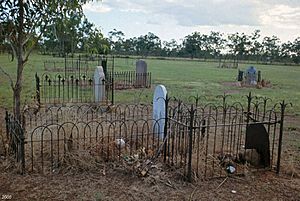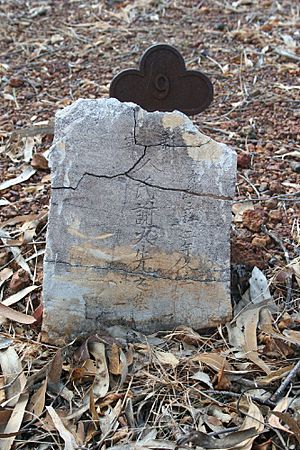Normanton Cemetery facts for kids
Quick facts for kids Normanton Cemetery |
|
|---|---|

Normanton Cemetery, 2000
|
|
| Location | Burke Developmental Road, Normanton, Shire of Carpentaria, Queensland, Australia |
| Design period | 1870s - 1890s (late 19th century) |
| Built | c. 1870 |
| Official name: Normanton Cemetery | |
| Type | state heritage (built, landscape) |
| Designated | 24 March 2000 |
| Reference no. | 601157 |
| Significant period | 1870- (fabric, social, historical) |
| Significant components | burial/grave, cemetery, grave surrounds - iron bedstead/s, trees/plantings, denominational divisions, memorial/monument, headstone, grave marker, grave surrounds/railings, gate - entrance |
| Lua error in Module:Location_map at line 420: attempt to index field 'wikibase' (a nil value). | |
Normanton Cemetery is a historic burial ground located on the Burke Developmental Road in Normanton, Queensland, Australia. It has been used since about 1870 and is still in use today. This cemetery is very important because it tells us a lot about the history of the area. It is officially listed on the Queensland Heritage Register.
Contents
History of Normanton Cemetery
The Normanton Cemetery has served the town and surrounding areas for over 150 years. It holds many unique memorials and gives us clues about how the region developed since it was first settled.
Early Days of Normanton
The first European settlers in this part of north-west Queensland arrived in the 1860s. The town of Normanton was started in 1864. It was a port and a service hub for the nearby cattle stations. By 1868, Normanton was officially declared a town.
In 1879, a famous company called Burns Philp set up a store here. Normanton was a key port for sending goods and people to places like Europe, China, and India. Products like wool, meat, and later minerals were shipped from here. At one point, people even thought Normanton might be the end point for a railway line that would cross all of Australia!
Gold Rush and Growth
In 1885, gold was found near Croydon. This made Normanton even more important because it was the closest port. The demand for transport led to the building of the Normanton to Croydon railway line in 1891.
By this time, about 2,000 people lived in Normanton. It was a busy centre with government offices, a police court, a customs house, and many hotels. There were also two churches, a hospital, and a school. The town even had two newspapers and was connected to the outside world by telegraph. A steamer ship came weekly, and the train ran to Croydon three times a week.
Changes Over Time
Normanton did not grow as much as its early planners hoped. When mineral prices dropped and mining slowed down, cattle became the main export by the time of the First World War.
Over time, the steamer service became less frequent. By the 1960s, new roads were built, connecting Normanton to other coastal towns in Queensland. This meant the town was less isolated, but trade also shifted. As fewer people worked in rural areas, the town slowly became smaller. Today, the Carpentaria Shire has about 4,200 people, including a large Aboriginal and Torres Strait Islander community.
Despite these changes, the Normanton Cemetery has continued to be used by the community for over 130 years.
What You'll See at Normanton Cemetery
The Normanton Cemetery covers a large area of flat land on the edge of town. Wooden gates mark the entrance to this well-kept cemetery. When you enter, you'll see newer lawn plots to your right. The oldest graves are found further back. A modern fence surrounds the entire cemetery, with a few trees along the fence line.
Sections and Graves
The cemetery is divided into different areas. There are sections for early graves, an old Chinese section, and areas for various religious groups. There is also a newer lawn cemetery. Most of the graves have not been moved. Some even date back to before the cemetery was officially set up.
The burial records start from August 1887, but one of the oldest headstones is from January 1870. In total, there are over 1,000 names in the burial register, and the cemetery is still in use today.
Unique Memorials
You'll find a wide variety of memorials here. They range from fancy marble and sandstone headstones to unusual wrought iron bedsteads. Some are very simple, while others are highly decorated. Some are well-preserved, and others are just faint traces.
The Chinese section is especially interesting. It shows the important role Chinese people played in developing the area.
Many headstones are small. This shows how difficult it was to transport large stones to this isolated part of Queensland. Some graves are still surrounded by strong wrought iron railings. Others have sheet metal or small shelters over them, sometimes for flowers.
You might also see graves of small children marked by iron bedsteads. Some even have the frames for mosquito nets still attached. Some graves are decorated with large seashells. One grave is outlined with big turbinate seashells and covered with small gravel.
There is also one Commonwealth war grave for a soldier from World War II.
Why Normanton Cemetery is Important
Normanton Cemetery was added to the Queensland Heritage Register in 2000. This means it's recognized as a place of special historical importance.
Showing Queensland's History
The cemetery has been used since at least 1870. It shows how the Normanton region has grown and changed over time. The messages on the headstones and the types of materials used can tell us about the people who lived here. You can learn about their background, health, social standing, jobs, and even why they died. The many single graves show how hard and isolated life was for early settlers in north-west Queensland.
A Record of Culture
The cemetery is an important record of the area's cultural development. It shows the different groups of people, their jobs, and their social status in Normanton and the Carpentaria Shire since the first settlements.
Special Connection to the Community
The cemetery has a strong and special meaning for the community. It has been used as a burial place for 130 years, which gives it great spiritual and symbolic value to the people of the region.


